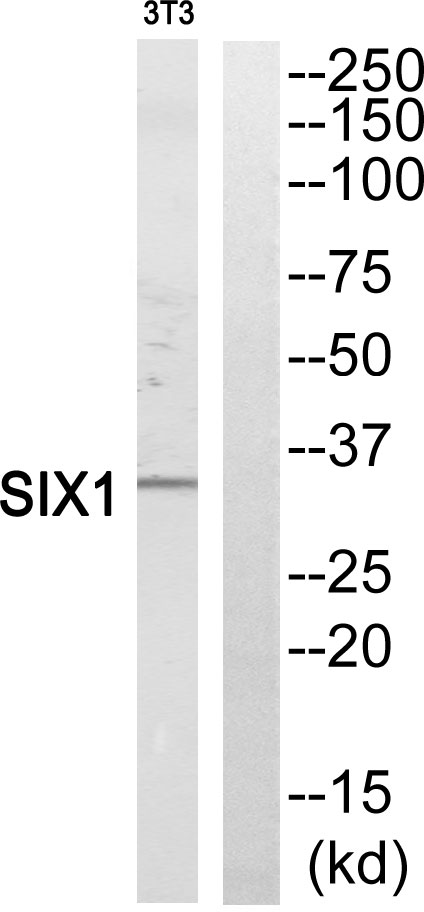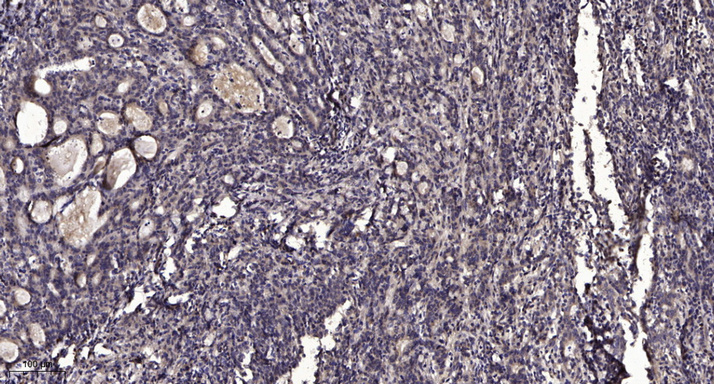Six1 Polyclonal Antibody
- Catalog No.:YT4305
- Applications:WB;ELISA;IHC
- Reactivity:Human;Mouse
- Target:
- Six1
- Fields:
- >>Transcriptional misregulation in cancer
- Gene Name:
- SIX1
- Protein Name:
- Homeobox protein SIX1
- Human Gene Id:
- 6495
- Human Swiss Prot No:
- Q15475
- Mouse Gene Id:
- 20471
- Mouse Swiss Prot No:
- Q62231
- Immunogen:
- The antiserum was produced against synthesized peptide derived from human SIX1. AA range:111-160
- Specificity:
- Six1 Polyclonal Antibody detects endogenous levels of Six1 protein.
- Formulation:
- Liquid in PBS containing 50% glycerol, 0.5% BSA and 0.02% sodium azide.
- Source:
- Polyclonal, Rabbit,IgG
- Dilution:
- WB 1:500-2000;IHC 1:50-300; ELISA 2000-20000
- Purification:
- The antibody was affinity-purified from rabbit antiserum by affinity-chromatography using epitope-specific immunogen.
- Concentration:
- 1 mg/ml
- Storage Stability:
- -15°C to -25°C/1 year(Do not lower than -25°C)
- Other Name:
- SIX1;Homeobox protein SIX1;Sine oculis homeobox homolog 1
- Observed Band(KD):
- 33kD
- Background:
- The protein encoded by this gene is a homeobox protein that is similar to the Drosophila 'sine oculis' gene product. This gene is found in a cluster of related genes on chromosome 14 and is thought to be involved in limb development. Defects in this gene are a cause of autosomal dominant deafness type 23 (DFNA23) and branchiootic syndrome type 3 (BOS3). [provided by RefSeq, Jul 2008],
- Function:
- disease:Defects in SIX1 are the cause of autosomal dominant deafness type 23 (DFNA23) [MIM:605192].,disease:Defects in SIX1 are the cause of branchiootic syndrome type 3 (BOS3) [MIM:608389]. Urinary tract malformations constitute the most frequent cause of chronic renal failure in the first two decades of life. Branchio-oto-renal syndrome (BOR) is an autosomal dominant developmental disorder of kidney and urinary tract malformations with hearing loss. The major feature of BOR is hearing loss (93% of patients), which can be conductive, sensorineural, or both and varies in age of onset.,function:May be involved in limb tendon and ligament development.,similarity:Belongs to the SIX/Sine oculis homeobox family.,similarity:Contains 1 homeobox DNA-binding domain.,tissue specificity:Specifically expressed in skeletal muscle.,
- Subcellular Location:
- Nucleus . Cytoplasm.
- Expression:
- Specifically expressed in skeletal muscle.
- June 19-2018
- WESTERN IMMUNOBLOTTING PROTOCOL
- June 19-2018
- IMMUNOHISTOCHEMISTRY-PARAFFIN PROTOCOL
- June 19-2018
- IMMUNOFLUORESCENCE PROTOCOL
- September 08-2020
- FLOW-CYTOMEYRT-PROTOCOL
- May 20-2022
- Cell-Based ELISA│解您多样本WB检测之困扰
- July 13-2018
- CELL-BASED-ELISA-PROTOCOL-FOR-ACETYL-PROTEIN
- July 13-2018
- CELL-BASED-ELISA-PROTOCOL-FOR-PHOSPHO-PROTEIN
- July 13-2018
- Antibody-FAQs
- Products Images

- Western blot analysis of SIX1 Antibody. The lane on the right is blocked with the SIX1 peptide.

- Immunohistochemical analysis of paraffin-embedded human Gastric adenocarcinoma. 1, Antibody was diluted at 1:200(4° overnight). 2, Tris-EDTA,pH9.0 was used for antigen retrieval. 3,Secondary antibody was diluted at 1:200(room temperature, 45min).



